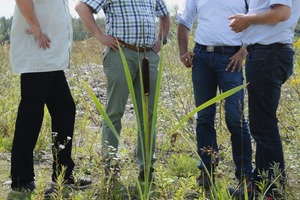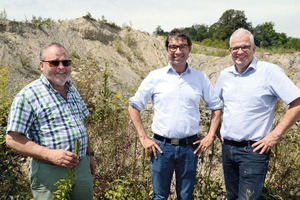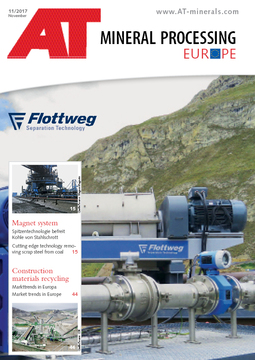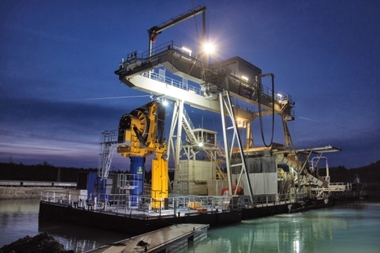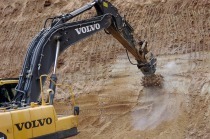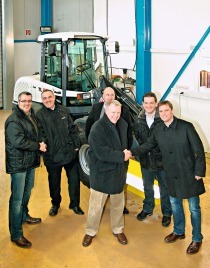Excavator tracks becoming potential biotopes
“Every excavator track is a potential biotope if you leave it to nature and to itself,” said Environmental State Secretary Andre Baumann, when he looked together with Dr Rolf Mohr, Senior Partner at Meichle + Mohr, and Thomas Beisswenger, General Secretary of the Association of the Non-Metallic Minerals Industry in Baden-Württemberg, around the 120-hectare extraction site and at the dredger used for wet extraction. Especially at the edges of the extraction areas, but also on the ground still driven over by wheel loaders and trucks, large puddles have formed with frog spawn floating in them. These interested Andre Baumann, who has a PhD in biology, just as much as the habitats of natterjack toads, yellow-bellied toads and sand lizards, or the steep faces created by the excavator shovels, in which rare sand martins have bored their breeding tunnels.
On the open gravel, loam and sand ground, the little ringed plover, woodlarks and especially rare ground beetles, which stand on the lists of endangered animal species, had all been sighted. These were all species that would hardly have a chance of survival in today’s cultural landscape. Dr Rolf Mohr spoke on the research he commissioned that has lasted over 20 years at the extraction site in the Radolfzell Municipal Forest and the company Schray in neighbouring Steisslingen. The landscape ecologist Jürgen Trautner from Filderstadt has summarized this in a book entitled “Development of a gravel extraction landscape in Hegau in the western region of Lake Constance – findings of research on the vegetation and fauna in the period 1992 to 2013“. Dr Rolf Mohr has already extended the commission for research work and mapping up to the year 2024.
“At Meichle + Mohr, it has been shown that ecology and economy can be brought together,” said State Secretary Baumann, praising the work done so far. The extraction sites had become new oases for many animal and plant species. For pioneering species on this area, pioneering habitats have been created. They show how good it was that public and private nature conservation and the raw material industry are working closer together. With the raw material strategy for Baden-Württemberg to be compiled presently, progress is being made in the next step in this cooperation. All involved must be clear that Germany needed the raw materials from Baden-Württemberg and did not want to import these from overseas. The goal of the raw materials strategy had to be to utilize the natural resources in the country and therefore to think about how regional raw materials supply should be organized and how possible new developments should be managed. To achieve this goal, everyone must enter into dialogue and sit together in participation and negotiation processes.
$(LEhttp://

